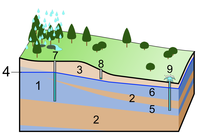
Photo from wikipedia
Drought season when compounded with El Niño phenomenon may implicate the availability of water resources and subsequently impact the quality of domestic, irrigation, and water industry. This has sparked the… Click to show full abstract
Drought season when compounded with El Niño phenomenon may implicate the availability of water resources and subsequently impact the quality of domestic, irrigation, and water industry. This has sparked the investigations to be undertaken regarding the hydrochemical traits of surface water and groundwater for alluvial aquifer in Penang and Kedah at Riverbank Filtration (RBF) sites. From this work, 121 samples of groundwater and surface water of standard drinking water quality for both wet and dry seasons have been collected and analysed for various parameters and indices. The resulting outcomes have illuminated several outcomes. The results showed that, firstly, the sequences of major cations and anions were Na+ > Mg2+ > Ca2+ > K+ and HCO3− > Cl− > SO42− > NO3−, respectively. The resulting Piper and Gibb’s diagrams both have indicated that water-rock interaction has caused groundwater and surface water to transform. Secondly, geochemical relationship has indicated that groundwater chemistry is primarily controlled by the mechanism of carbonate mineral gypsum and halite dissolution. They have also highlighted ion exchange to be the secondary processes yielding higher concentration of Na+ and Mg2+ ions. Thirdly, the index method assessments have yielded similar outcomes for a majority of them, indicating that all groundwater and surface water samples can be categorised as excellent and excellent to good categories respectively. However, only PI method has resulted in 62% of the samples to be classified as unsuitable for irrigation, as its calculated equation scored > 75. Therefore, it can be concluded that groundwater and surface water are both typically acceptable for irrigation uses.
Journal Title: Arabian Journal of Geosciences
Year Published: 2019
Link to full text (if available)
Share on Social Media: Sign Up to like & get
recommendations!